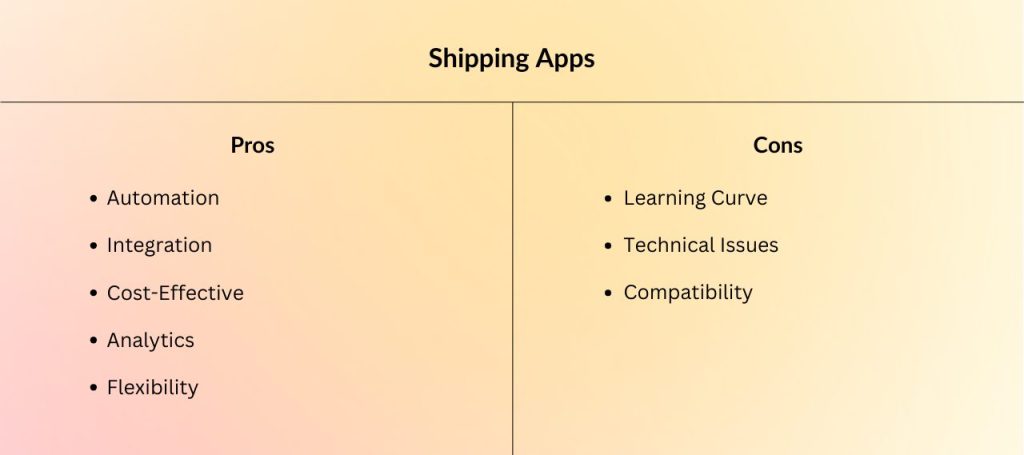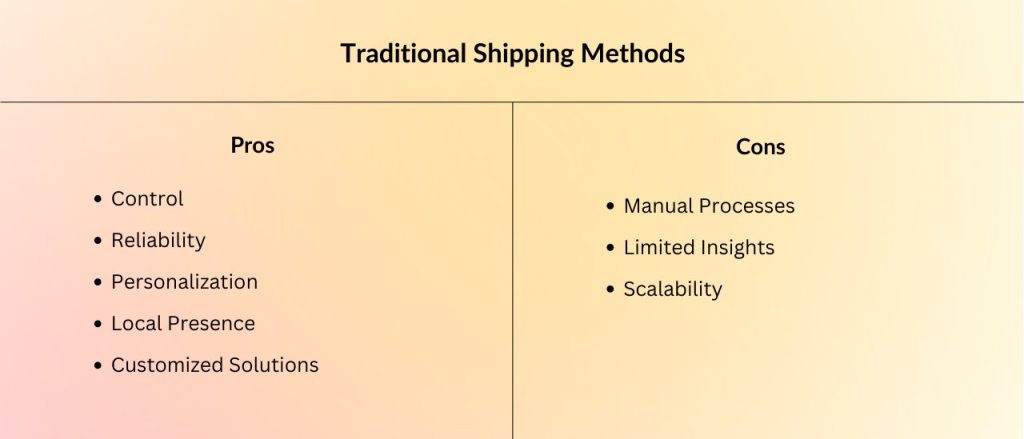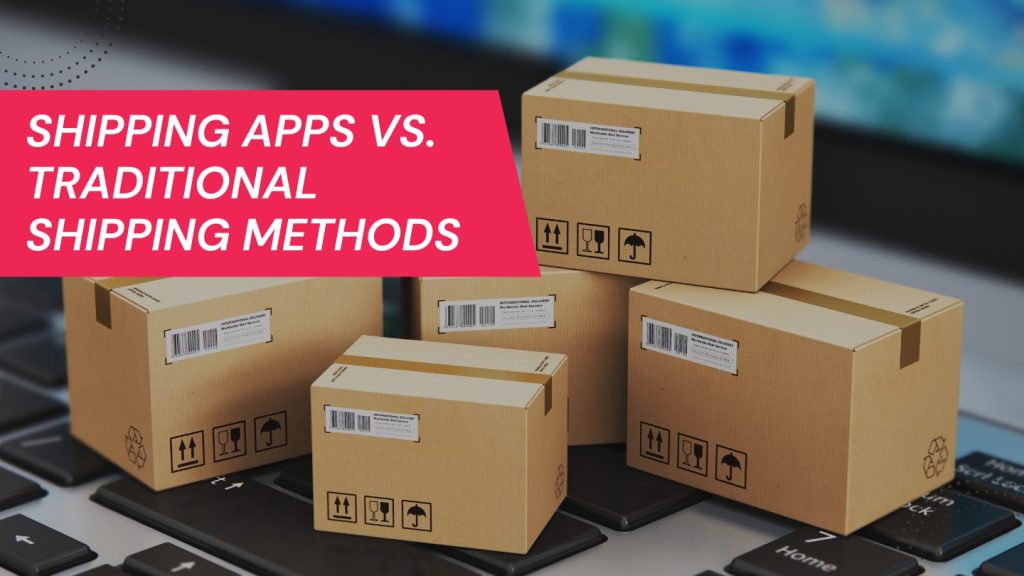With the rise of technology, shipping apps have emerged as popular tools for managing and streamlining shipping processes. However, traditional shipping methods still hold their ground in certain scenarios. If you are reading this article, you are probably about to decide between the two. In this article, we\’ll explore the pros and cons of shipping apps versus traditional shipping methods to help you make informed decisions for your shipping strategies.
Shipping Apps
Shipping apps have rapidly grown, with the global market reaching $1.5 billion in 2020 and expected to hit $2.9 billion by 2025, growing at a CAGR of 13.4%. These apps integrate seamlessly with platforms like Shopify, WooCommerce, and Magento, enabling centralized order management, label generation, shipment tracking, and customer communication. Businesses using them report a 15% cost savings on shipping compared to traditional methods, thanks to negotiated rates and bulk shipping options. They also improve customer satisfaction, with 87% of customers prioritizing shipping options and delivery times for online purchases.

Pros:
1. Automation
Shipping apps automate various aspects of the shipping process, such as label generation, order tracking, and customer notifications, saving time and reducing manual errors.
2. Integration
Many shipping apps seamlessly integrate with e-commerce platforms, allowing for smooth order fulfillment and inventory management.
3. Cost-Effective
Some shipping apps offer discounted shipping rates and bulk shipping options, helping businesses save on shipping costs.
4. Analytics
Shipping apps provide valuable analytics and insights into shipping performance, delivery times, and customer satisfaction, enabling businesses to make data-driven decisions.
5. Flexibility
Shipping apps offer flexibility in choosing shipping carriers, delivery options, and shipping schedules, catering to diverse customer needs.
Cons:
1. Learning Curve
Implementing and learning to use a new shipping app may require time and training for staff members.
2. Technical Issues
Like any software, shipping apps may encounter technical issues or downtime, affecting order processing and delivery timelines.
3. Compatibility
Not all shipping apps may be compatible with specific e-commerce platforms or business systems, limiting integration options for some businesses.
Traditional Shipping Methods
Traditional shipping methods refer to established practices and systems used for transporting goods from one location to another. These methods often involve relying on well-known shipping carriers and logistics companies to handle the transportation and delivery of packages. Traditional shipping methods may include using standard postal services, courier companies, freight services, or dedicated shipping providers. They typically follow a set process of package pickup, sorting, transportation, and delivery, with established timelines and service levels. While traditional shipping methods may lack some of the advanced features and automation found in shipping apps, they offer reliability, familiarity, and often a range of shipping options suitable for various businesses and shipping needs.

Pros:
1. Control
With traditional shipping methods, businesses have more control over the shipping process, carrier selection, and shipping timelines.r adipiscing elit. Ut elit tellus, luctus nec ullamcorper mattis, pulvinar dapibus leo.
2. Reliability
Established shipping carriers and methods often have a proven track record of reliability and timely deliveries.
3. Personalization
Some businesses prefer traditional shipping methods for the ability to personalize packaging, add promotional materials, and include handwritten notes for customers
4. Local Presence
Traditional shipping methods may be advantageous for businesses with a strong local presence, allowing for quicker deliveries and personalized customer experiences.
5. Customized Solutions
Some businesses require customized shipping solutions or specialized services that traditional carriers can offer.
Cons:
1. Cost
Traditional shipping methods may be more expensive, especially for small businesses or businesses with high shipping volumes.
2. Manual Processes
Traditional shipping methods often involve manual processes, such as label printing and order tracking, which can be time-consuming and prone to errors.
3. Limited Insights
Unlike shipping apps, traditional methods may provide limited insights and analytics into shipping performance and customer satisfaction.
4. Scalability
Scaling shipping operations with traditional methods may pose challenges, especially during peak seasons or periods of increased demand.
Factors to Consider When Choosing Between Shipping Apps & Traditional Shipping Methods
When deciding between shipping apps and traditional shipping methods, several crucial factors come into play. These considerations can significantly impact your business operations, cost-effectiveness, customer satisfaction, and overall shipping efficiency. By carefully evaluating these factors, you can make an informed decision that aligns with your business goals and shipping requirements.
Cost: Compare the overall costs, including shipping rates, fees, and any additional charges associated with each option.
Efficiency: Evaluate the speed and reliability of delivery offered by both shipping apps and traditional methods to ensure timely and consistent shipments.
Integration: Consider how well each option integrates with your existing e-commerce platform, inventory management system, and other business tools.
Flexibility: Assess the flexibility of shipping options, carriers, delivery times, and shipping schedules provided by each method.
Customer Experience: Prioritize customer satisfaction by choosing a shipping method that offers transparent tracking, accurate delivery estimates, and responsive customer support.
Scalability: Consider the scalability of each shipping solution, especially if your business experiences fluctuations in shipping volume or seasonal demand.
Technical Requirements: Evaluate the technical requirements, training, and implementation processes involved in adopting shipping apps versus traditional methods.
Reliability: Consider the track record and reliability of shipping carriers or providers associated with each option to minimize shipping delays and issues.
Customization: Determine the level of customization and personalization options available for packaging, labeling, and customer communications.
Industry Compliance: Ensure that your chosen shipping method complies with industry regulations, shipping standards, and legal requirements relevant to your business operations.
In conclusion, both shipping apps and traditional shipping methods have their advantages and disadvantages. The choice between the two depends on factors such as business size, shipping volume, budget, technical capabilities, and specific shipping needs. Many businesses opt for a hybrid approach, leveraging the strengths of both shipping apps and traditional methods to optimize their shipping strategies and provide excellent customer experiences. Ultimately, the key is to evaluate and choose the shipping solution that best aligns with your business goals and customer expectations.


